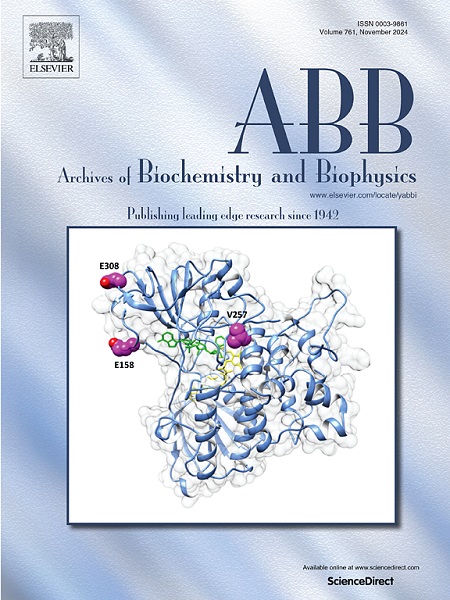Mechanisms and applications of bacterial luciferase and its auxiliary enzymes
IF 3.8
3区 生物学
Q2 BIOCHEMISTRY & MOLECULAR BIOLOGY
引用次数: 0
Abstract
Bacterial luciferase (LuxAB) catalyzes the conversion of reduced flavin mononucleotide (FMNH⁻), oxygen, and a long-chain aldehyde to oxidized FMN, the corresponding acid and water with concomitant light emission. This bioluminescence reaction requires the reaction of a flavin reductase such as LuxG (in vivo partner of LuxAB) to supply FMNH⁻ for the LuxAB reaction. LuxAB is a well-known self-sufficient luciferase system because both aldehyde and FMNH⁻ substrates can be produced by the associated enzymes encoded by the genes in the lux operon, allowing the system to be auto-luminous. This makes it useful for in vivo applications. Structural and functional studies have long been performed in efforts to gain a better understanding of the LuxAB reaction. Recently, continued exploration of the LuxAB reaction have elucidated the mechanisms of C4a-hydroperoxyflavin formation and identified key catalytic residues such as His44 that facilitates the generation of flavin intermediates important for light generation. Advancements in protein engineering and synthetic biology have improved the bioluminescence properties of LuxAB. Various applications of LuxAB for bioimaging, bioreporters, biosensing in metabolic engineering and real-time monitoring of aldehyde metabolites in biofuel production pathways have been developed during the last decade. Challenging issues such as achieving red-shifted emissions, optimizing the signal intensity and identifying mechanisms related to the generation of light-emitting species remain to be explored. Nevertheless, LuxAB continues to be a promising tool for diverse biotechnological and biomedical applications.

细菌荧光素酶及其辅助酶的作用机制及应用。
细菌荧光素酶(LuxAB)催化还原黄素单核苷酸(FMNH),氧和长链醛转化为氧化的FMN,相应的酸和水,并伴随发光。这种生物发光反应需要黄素还原酶如LuxG (LuxAB的体内伙伴)的反应来提供FMNH⁻(为LuxAB反应提供FMNH⁻)。LuxAB是一个众所周知的自给自足的荧光素酶系统,因为醛和FMNH -底物都可以由lux操纵子中基因编码的相关酶产生,从而使该系统能够自动发光。这使得它对体内应用很有用。长期以来,人们一直在进行结构和功能研究,以更好地了解LuxAB反应。最近,LuxAB反应的持续探索已经阐明了c4a -氢过氧黄素形成的机制,并确定了His44等促进黄素中间体生成的关键催化残基,这些中间体对光的产生很重要。蛋白质工程和合成生物学的进步改善了LuxAB的生物发光特性。在过去十年中,LuxAB在生物成像、生物报告、代谢工程中的生物传感和生物燃料生产途径中醛代谢物的实时监测等方面的各种应用得到了发展。诸如实现红移发射、优化信号强度以及确定与发光物种产生相关的机制等具有挑战性的问题仍有待探索。尽管如此,LuxAB仍然是各种生物技术和生物医学应用的有前途的工具。
本文章由计算机程序翻译,如有差异,请以英文原文为准。
求助全文
约1分钟内获得全文
求助全文
来源期刊

Archives of biochemistry and biophysics
生物-生化与分子生物学
CiteScore
7.40
自引率
0.00%
发文量
245
审稿时长
26 days
期刊介绍:
Archives of Biochemistry and Biophysics publishes quality original articles and reviews in the developing areas of biochemistry and biophysics.
Research Areas Include:
• Enzyme and protein structure, function, regulation. Folding, turnover, and post-translational processing
• Biological oxidations, free radical reactions, redox signaling, oxygenases, P450 reactions
• Signal transduction, receptors, membrane transport, intracellular signals. Cellular and integrated metabolism.
 求助内容:
求助内容: 应助结果提醒方式:
应助结果提醒方式:


